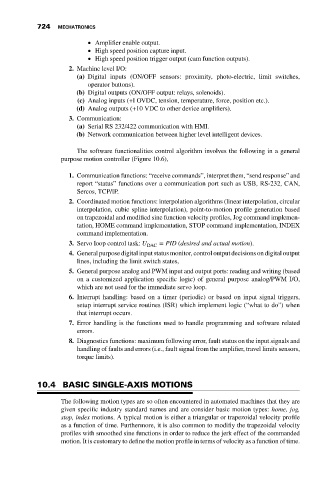Page 738 - Mechatronics with Experiments
P. 738
724 MECHATRONICS
Amplifier enable output.
High speed position capture input.
High speed position trigger output (cam function outputs).
2. Machine level I/O:
(a) Digital inputs (ON/OFF sensors: proximity, photo-electric, limit switches,
operator buttons).
(b) Digital outputs (ON/OFF output: relays, solenoids).
(c) Analog inputs (+I OVDC, tension, temperature, force, position etc.).
(d) Analog outputs (+10 VDC to other device amplifiers).
3. Communication:
(a) Serial RS 232/422 communication with HMI.
(b) Network communication between higher level intelligent devices.
The software functionalities control algorithm involves the following in a general
purpose motion controller (Figure 10.6),
1. Communication functions: “receive commands”, interpret them, “send response” and
report “status” functions over a communication port such as USB, RS-232, CAN,
Sercos, TCP/IP.
2. Coordinated motion functions: interpolation algorithms (linear interpolation, circular
interpolation, cubic spline interpolation), point-to-motion profile generation based
on trapezoidal and modified sine function velocity profiles, Jog command implemen-
tation, HOME command implementation, STOP command implementation, INDEX
command implementation.
3. Servo loop control task: U DAC = PID (desired and actual motion).
4. General purpose digital input status monitor, control output decisions on digital output
lines, including the limit switch states,
5. General purpose analog and PWM input and output ports: reading and writing (based
on a customized application specific logic) of general purpose analog/PWM I/O,
which are not used for the immediate servo loop.
6. Interrupt handling: based on a timer (periodic) or based on input signal triggers,
setup interrupt service routines (ISR) which implement logic (“what to do”) when
that interrupt occurs.
7. Error handling is the functions used to handle programming and software related
errors.
8. Diagnostics functions: maximum following error, fault status on the input signals and
handling of faults and errors (i.e., fault signal from the amplifier, travel limits sensors,
torque limits).
10.4 BASIC SINGLE-AXIS MOTIONS
The following motion types are so often encountered in automated machines that they are
given specific industry standard names and are consider basic motion types: home, jog,
stop, index motions. A typical motion is either a triangular or trapezoidal velocity profile
as a function of time. Furthermore, it is also common to modifiy the trapezoidal velocity
profiles with smoothed sine functions in order to reduce the jerk effect of the commanded
motion. It is customary to define the motion profile in terms of velocity as a function of time.

